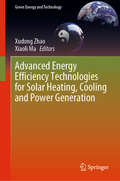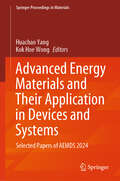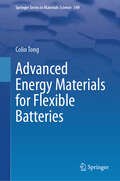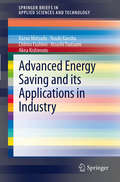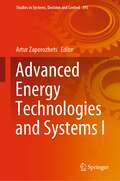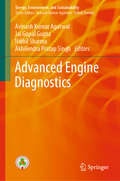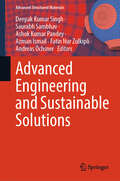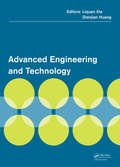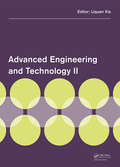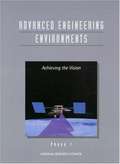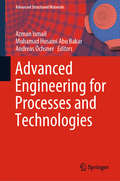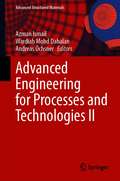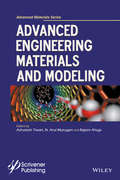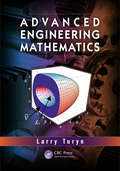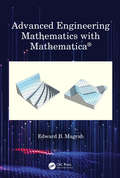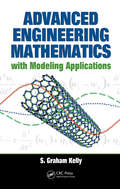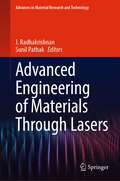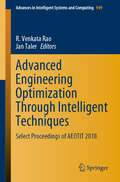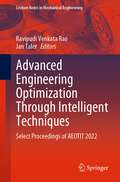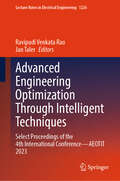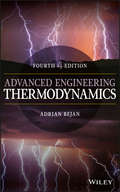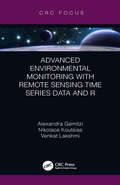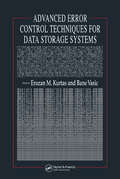- Table View
- List View
Advanced Energy Efficiency Technologies for Solar Heating, Cooling and Power Generation (Green Energy and Technology)
by Xudong Zhao Xiaoli MaThis book, based on the research experience and outcomes of a group of international contributors, addresses a range of advanced energy efficiency technologies and their applications in solar heating, cooling and power generation, while also providing solutions for tackling recurring low efficiency problems in today’s systems. It highlights the latest technologies and methods, which can significantly improve the performance of solar systems, enabling readers to design, construct and apply high-performance solar systems in or for their own projects. The contributors provide a systematic introduction to state-of-the-art energy efficiency technologies that demonstrates how to implement innovative solar systems. These technologies include: • heat pipes and loop heat pipes; • phase change materials (PCMs) and PCM slurries; • micro-channel panels; • desiccant/adsorption cycling; • ejector cooling and heat pumps; and • solar concentration and thermoelectric units. The book shows how innovative solar systems applicable to rural and urban buildings can be analysed and demonstrates the successful implementation of these advanced technologies. It delivers the design principles and associated energy performance assessment methods for a range of selected solar heating, cooling and power generation projects. This book offers a valuable source of information for final-year undergraduate students, as well as graduate students and academic lecturers, as it promotes the widespread deployment of advanced solar heating, cooling and power generation technologies applicable for buildings across the globe. The book is also a good point of reference for design engineers and energy consultants who wish to extend their knowledge of advanced technologies used to achieve energy efficiency.
Advanced Energy Materials
by Ashutosh Tiwari Sergiy ValyukhAn essential resource for scientists designing new energy materials for the vast landscape of solar energy conversion as well as materials processing and characterizationBased on the new and fundamental research on novel energy materials with tailor-made photonic properties, the role of materials engineering has been to provide much needed support in the development of photovoltaic devices. Advanced Energy Materials offers a unique, state-of-the-art look at the new world of novel energy materials science, shedding light on the subject's vast multi-disciplinary approachThe book focuses particularly on photovoltaics, efficient light sources, fuel cells, energy-saving technologies, energy storage technologies, nanostructured materials as well as innovating materials and techniques for future nanoscale electronics. Pathways to future development are also discussed.Critical, cutting-edge subjects are addressed, including:Non-imaging focusing heliostat; state-of-the-art of nanostructuresMetal oxide semiconductors and their nanocompositesSuperionic solids; polymer nanocomposites; solid electrolytes; advanced electronicsElectronic and optical properties of lead sulfideHigh-electron mobility transistors and light-emitting diodesAnti-ferroelectric liquid crystals; PEEK membrane for fuel cellsAdvanced phosphors for energy-efficient lightingMolecular computation photovoltaics and photocatalystsPhotovoltaic device technology and non-conventional energy applicationsReadershipThe book is written for a large and broad readership including researchers and university graduate students from diverse backgrounds such as chemistry, materials science, physics, and engineering working in the fields of nanotechnology, photovoltaic device technology, and non-conventional energy.
Advanced Energy Materials and Their Application in Devices and Systems: Selected Papers of AEMDS 2024 (Springer Proceedings in Materials #62)
by Huachao Yang Kok Hoe WongThis book provides insights into cutting-edge developments in energy materials, devices, and systems, as presented at the International Conference on Advanced Energy Materials, Devices, and Systems (AEMDS 2024) in Ningbo, China, from June 28 to 29, 2024. Focusing on the global demand for high-performance energy storage devices, the conference explores advancements in materials crucial for their development. AEMDS 2024 serves as a platform for discussions on experimental breakthroughs, ongoing developments, and practical applications in the field. Keynote and invited speakers from the global energy domain contribute to a dynamic exchange of ideas, promoting a deeper understanding of emerging energy materials and their applications across various research fields.
Advanced Energy Materials for Flexible Batteries (Springer Series in Materials Science #349)
by Colin TongThis book provides a comprehensive guide to the cutting-edge science and engineering behind the development of flexible batteries. These innovative devices, capable of bending, twisting, and stretching, hold immense potential for applications ranging from wearable electronics to large-scale energy storage systems. The book presents a thorough overview of the essential materials and design principles that underpin flexible battery technology. It explores the latest advancements in electrode materials, electrolytes, and separators, focusing on materials that exhibit exceptional flexibility, high energy density, and excellent rate capability. In addition to materials selection, the book addresses the challenges and opportunities associated with designing and manufacturing flexible batteries. It discusses strategies for creating flexible battery cells that can withstand mechanical deformation, as well as efficient manufacturing processes and performance evaluation methods. By offering a deep understanding of the materials science and engineering principles governing flexible batteries, this book aims to inspire further research and development in this rapidly evolving field. This book is an essential resource for engineers and materials scientists involved in battery development.
Advanced Energy Saving and its Applications in Industry (SpringerBriefs in Applied Sciences and Technology)
by Atsushi Tsutsumi Akira Kishimoto Chihiro Fushimi Yasuki Kansha Kazuo MatsudaThe conventional approach for energy saving in a process system is to maximize heat recovery without changing any process conditions by using pinch technology. "Self-heat recuperation technology" was developed to achieve further energy saving in the process system by eliminating the necessity for any external heat input, such as firing or imported steam. Advanced Energy Saving and its Applications in Industry introduces the concept of self-heat recuperation and the application of such technology to a wide range of processes from heavy chemical complexes to other processes such as drying and gas separation processes, which require heating and cooling during operation. Conventional energy saving items in a utility system are applied and implemented based on a single site approach, however, when looking at heavy chemical complexes, it was apparent that the low-grade heat discharged as waste from a refinery could also be used in an adjacent petrochemical plant. There could therefore be a large energy saving potential by utilizing the surplus heat across the sites. Advanced Energy Saving and its Applications in Industry assesses conventional approaches to industrial energy saving and explains and outlines new methods to provide even greater energy saving potential. Advanced Energy Saving and its Applications in Industry provides a key resource and research tool for all those involved in developing the energy efficiency of industrial processes. Researchers, industry professionals and even students with an interest in green engineering will find the summaries of the conventional and suggested new methods useful when attempting to advance further development within this field.
Advanced Energy Technologies and Systems I (Studies in Systems, Decision and Control #395)
by Artur ZaporozhetsThis book focuses on modern technologies and systems for solving problems in the energy sector. It is shown that bioenergy is one of the promising areas of energy development. The book collected the experience of scientists from many countries in the research of renewable energy. The advantages of renewable energy are general availability, renewability, environmental friendliness. The analysis carried out by the authors shows the current state of renewable energy in the world, its trends and prospects. New measuring systems are presented, which can become the basis for measuring the thermal characteristics of various types of fuels, including biofuels, insulating materials, enclosing structures, etc. System for monitoring of grainy biomass comminution with the use of genetic algorithms has been presented and described. New technologies for the construction of power plants based on renewable energy sources have been proposed and investigated.
Advanced Engine Diagnostics (Energy, Environment, and Sustainability)
by Avinash Kumar Agarwal Jai Gopal Gupta Nikhil Sharma Akhilendra Pratap SinghThis book describes the discusses advanced fuels and combustion, emission control techniques, after-treatment systems, simulations and fault diagnostics, including discussions on different engine diagnostic techniques such as particle image velocimetry (PIV), phase Doppler interferometry (PDI), laser ignition. This volume bridges the gap between basic concepts and advanced research in internal combustion engine diagnostics, making it a useful reference for both students and researchers whose work focuses on achieving higher fuel efficiency and lowering emissions.
Advanced Engineering and Sustainable Solutions (Advanced Structured Materials #228)
by Deepak Kumar Singh Saurabh Sambhav Ashok Kumar Pandey Azman Ismail Fatin Nur Zulkipli Andreas ÖchsnerThis book is a comprehensive collection of cutting-edge research that addresses some of the most pressing challenges in modern engineering and applied sciences. This book features 26 chapters, each delving into innovative methodologies, advanced techniques, and sustainable solutions across a diverse range of disciplines. Each chapter presents rigorous analysis, practical applications, and forward-thinking solutions, making this book an essential resource for researchers, engineers, and professionals seeking to expand their knowledge and contribute to the advancement of sustainable technologies in their respective fields.
Advanced Engineering and Technology: Proceedings of the 2014 Annual Congress on Advanced Engineering and Technology (CAET 2014), Hong Kong, 19-20 April 2014
by Liquan Xie Dianjian HuangAdvanced Engineering and Technology contains 110 technical papers from the 2014 Annual Congress on Advanced Engineering and Technology (CAET 2014, Hong Kong, 19-20 April 2014, including the 4th Workshop on Applied Mechanics and Civil Engineering, AMCE 2014). The contributions focus on advanced theories and technologies related to building engineeri
Advanced Engineering and Technology II: Proceedings of the 2nd Annual Congress on Advanced Engineering and Technology (CAET 2015), Hong Kong, 4-5 April 2015
by Liquan XieAdvanced Engineering and Technology II collects recent essential ideas and advanced techniques to overcome the current engineering issues in civil engineering, environmental engineering, water science and hydraulic engineering, energy and chemical engineering, and other related fields. The 60 technical papers from the 2nd Annual Congress on Advance
Advanced Engineering Dynamics
by Jerry H. GinsbergThis text offers a clear and refreshing exposition of the dynamics of mechanical systems from an engineering perspective. The author thoroughly covers basic concepts and applies them in a systematic manner to solve problems in mechanical systems with applications to engineering. Numerous illustrative examples accompany all theoretical discussions, and each chapter offers a wealth of homework problems. The treatment of the kinematics of particles and rigid bodies is extensive. In this new edition the author has revised and reorganized sections to enhance understanding of physical principles, and he has modified and added examples, as well as homework problems. The new edition also contains a thorough development of computational methods for solving the differential equations of motion for constrained systems. Seniors and graduate students in engineering will find this book to be extremely useful. Solutions manual available.
Advanced Engineering Environments: Achieving the Vision
by National Research CouncilReport on Advanced Engineering Environments.
Advanced Engineering for Processes and Technologies (Advanced Structured Materials #102)
by Azman Ismail Muhamad Husaini Abu Bakar Andreas ÖchsnerThis book presents various state-of-the-art applications for the development of new materials and technologies, discussing computer-based engineering tools that are widely used in simulations, evaluation of data and design processes. For example, modern joining technologies can be used to fabricate new compound or composite materials, even those composed of dissimilar materials. Such materials are often exposed to harsh environments and must possess specific properties. Technologies in this context are mainly related to the transportation technologies in their wider sense, i.e. automotive and marine technologies, including ships, amphibious vehicles, docks, offshore structures, and robots. This book highlights the importance the finite element and finite volume methods that are typically used in the context of engineering simulations.
Advanced Engineering for Processes and Technologies II (Advanced Structured Materials #147)
by Azman Ismail Wardiah Mohd Dahalan Andreas ÖchsnerThis book “Advanced Engineering for Processes and Technologies II” provides a good platform for participating researchers and academicians to share their latest innovation, technology and research findings in the areas of marine engineering technology and applications, sea management as well as engineering education. It offers an opportunity for academicians of the Universiti Kuala Lumpur, Malaysian Institute of Marine Engineering Technology (UniKL MIMET) to exchange ideas and establish a professional network. There are more than 30 papers covering a wide range of topics related to technologies and education including simulation, intellectual discussion, environmental awareness, enhancement of knowledge and skills. The aim of this book focuses more on the numerous technological methods used for the establishment of engineering innovation and productivity through their competitive research findings and the exposure of their relative merits and limitations. The papers shared in this issue will enable other researchers to generate interest and novel ideas that can lead to the discovery of new engineering knowledge.
Advanced Engineering Materials and Modeling
by N. Arul Murugan Ashutosh Tiwari Rajeev AhujaThe engineering of materials with advanced features is driving the research towards the design of innovative materials with high performances. New materials often deliver the best solution for structural applications, precisely contributing towards the finest combination of mechanical properties and low weight. The mimicking of nature's principles lead to a new class of structural materials including biomimetic composites, natural hierarchical materials and smart materials. Meanwhile, computational modeling approaches are the valuable tools complementary to experimental techniques and provide significant information at the microscopic level and explain the properties of materials and their very existence. The modeling also provides useful insights to possible strategies to design and fabricate materials with novel and improved properties. The book brings together these two fascinating areas and offers a comprehensive view of cutting-edge research on materials interfaces and technologies the engineering materials. The topics covered in this book are divided into 2 parts" Engineering of Materials, Characterizations & Applications and Computational Modeling of Materials. The chapters include the following: Mechanical and resistance behavior of structural glass beams Nanocrystalline metal carbides - microstructure characterization SMA-reinforced laminated glass panel Sustainable sugarcane bagasse cellulose for papermaking Electrospun scaffolds for cardiac tissue engineering Bio-inspired composites Density functional theory for studying extended systems First principles based approaches for modeling materials Computer aided materials design Computational materials for stochastic electromagnets Computational methods for thermal analysis of heterogeneous materials Modelling of resistive bilayer structures Modeling tunneling of superluminal photons through Brain Microtubules Computer aided surgical workflow modeling Displaced multiwavelets and splitting algorithms
Advanced Engineering Mathematics
by Lawrence TurynBeginning with linear algebra and later expanding into calculus of variations, Advanced Engineering Mathematics provides accessible and comprehensive mathematical preparation for advanced undergraduate and beginning graduate students taking engineering courses. This book offers a review of standard mathematics coursework while effectively integrati
Advanced Engineering Mathematics with Mathematica
by Edward B. MagrabAdvanced Engineering Mathematics with Mathematica® presents advanced analytical solution methods that are used to solve boundary-value problems in engineering and integrates these methods with Mathematica® procedures. It emphasizes the Sturm–Liouville system and the generation and application of orthogonal functions, which are used by the separation of variables method to solve partial differential equations. It introduces the relevant aspects of complex variables, matrices and determinants, Fourier series and transforms, solution techniques for ordinary differential equations, the Laplace transform, and procedures to make ordinary and partial differential equations used in engineering non-dimensional. To show the diverse applications of the material, numerous and widely varied solved boundary value problems are presented.
Advanced Engineering Mathematics with Modeling Applications
by S. Graham KellyA graduate level text, this book presents a unique combination of theoretical mathematics and engineering applications. It demonstrates the relationship between advanced mathematics and engineering principles, introduces engineering mathematics at a theoretical level, and includes functional analysis topics such as vector spaces, inner products, and norms and develops advanced mathematical methods from this foundation. The author does not focus on proving theorems but on the application of the theorems to the solution of engineering problems. In sum, the book provides an overview of the principles and techniques of advanced mathematics as applied to mechanical engineering problems.
Advanced Engineering of Materials Through Lasers (Advances in Material Research and Technology)
by J. Radhakrishnan Sunil PathakThis book covers the fundamentals of different laser-based manufacturing and processing, namely laser shock peening, laser micromachining, laser cleaning, cladding, remelting, laser honing, and other several aspects of lasers. The book discusses the general laser interaction with different materials. The application of laser-based post-processing of additive manufacturing and repair engineering is reported. It also provides the reader with mechanism of lasers in manufacturing and recent developments in tools, technologies, controls, and operations.
Advanced Engineering Optimization Through Intelligent Techniques: Select Proceedings of AEOTIT 2018 (Advances in Intelligent Systems and Computing #949)
by R. Venkata Rao Jan TalerThis book comprises select peer-reviewed papers presented at the International Conference on Advanced Engineering Optimization Through Intelligent Techniques (AEOTIT) 2018. The book combines contributions from academics and industry professionals, and covers advanced optimization techniques across all major engineering disciplines like mechanical, manufacturing, civil, automobile, electrical, chemical, computer and electronics engineering. Different optimization techniques and algorithms such as genetic algorithm (GA), differential evolution (DE), simulated annealing (SA), particle swarm optimization (PSO), artificial bee colony (ABC) algorithm, artificial immune algorithm (AIA), teaching-learning-based optimization (TLBO) algorithm and many other latest meta-heuristic techniques and their applications are discussed. This book will serve as a valuable reference for students, researchers and practitioners and help them in solving a wide range of optimization problems.
Advanced Engineering Optimization Through Intelligent Techniques: Select Proceedings of AEOTIT 2022 (Lecture Notes in Mechanical Engineering)
by Ravipudi Venkata Rao Jan TalerThis book comprises peer-reviewed papers presented at the International Conference on Advanced Engineering Optimization Through Intelligent Techniques (AEOTIT) 2022. The book combines contributions from academics and industry professionals and covers advanced optimization techniques across all major engineering disciplines like mechanical, manufacturing, civil, automobile, electrical, chemical, computer, and electronics engineering. The book discusses different optimization techniques and algorithms such as genetic algorithm, non-dominated sorting genetic algorithm-II, and III, differential search, particle swarm optimization, fruit fly algorithm, cuckoo search, teaching–learning-based optimization algorithm, grey wolf optimization, Jaya algorithm, Rao algorithms, and many other latest meta-heuristic techniques and their applications. Various multi-attribute decision-making methods such as AHP, TOPSIS, ELECTRE, PROMETHEE, DEMATEL, R-method, fuzzy logic, and their applications are also discussed. This book serves as a valuable reference for students, researchers, and practitioners and helps them in solving a wide range of optimization problems.
Advanced Engineering Optimization Through Intelligent Techniques: Select Proceedings of the 4th International Conference—AEOTIT 2023 (Lecture Notes in Electrical Engineering #1226)
by Ravipudi Venkata Rao Jan TalerThis book comprises peer-reviewed papers presented at the 4th International Conference on Advanced Engineering Optimization Through Intelligent Techniques (AEOTIT) 2023. The book combines contributions from academics and industry professionals and covers advanced optimization techniques across all major engineering disciplines like mechanical, manufacturing, civil, electrical, chemical, computer, and electronics engineering. The book discusses different optimization techniques and algorithms such as genetic algorithm, non-dominated sorting genetic algorithm-II, and III, particle swarm optimization, gravitational search algorithm, ant lion optimization, dragonfly algorithm, teaching–learning-based optimization algorithm, grey wolf optimization, Jaya algorithm, Rao algorithms, many other latest meta-heuristic techniques, machine learning algorithms, and their applications. Various multi-attribute decision-making methods such as AHP, TOPSIS, PROMETHEE, desirability function, SWARA, R-method, BHARAT method, Taguchi method, fuzzy logic, and their applications are also discussed. This book serves as a valuable reference for students, researchers, and practitioners and helps them in solving a wide range of optimization problems.
Advanced Engineering Thermodynamics
by Adrian BejanAn advanced, practical approach to the first and second laws of thermodynamics Advanced Engineering Thermodynamics bridges the gap between engineering applications and the first and second laws of thermodynamics. Going beyond the basic coverage offered by most textbooks, this authoritative treatment delves into the advanced topics of energy and work as they relate to various engineering fields. This practical approach describes real-world applications of thermodynamics concepts, including solar energy, refrigeration, air conditioning, thermofluid design, chemical design, constructal design, and more. This new fourth edition has been updated and expanded to include current developments in energy storage, distributed energy systems, entropy minimization, and industrial applications, linking new technologies in sustainability to fundamental thermodynamics concepts. Worked problems have been added to help students follow the thought processes behind various applications, and additional homework problems give them the opportunity to gauge their knowledge. The growing demand for sustainability and energy efficiency has shined a spotlight on the real-world applications of thermodynamics. This book helps future engineers make the fundamental connections, and develop a clear understanding of this complex subject. Delve deeper into the engineering applications of thermodynamics Work problems directly applicable to engineering fields Integrate thermodynamics concepts into sustainability design and policy Understand the thermodynamics of emerging energy technologies Condensed introductory chapters allow students to quickly review the fundamentals before diving right into practical applications. Designed expressly for engineering students, this book offers a clear, targeted treatment of thermodynamics topics with detailed discussion and authoritative guidance toward even the most complex concepts. Advanced Engineering Thermodynamics is the definitive modern treatment of energy and work for today's newest engineers.
Advanced Environmental Monitoring with Remote Sensing Time Series Data and R
by Alexandra Gemitzi Nikolaos Koutsias Venkat LakshmiThis book provides a step-by-step guide on how to use various publicly available remotely sensed time series data sources for environmental monitoring and assessment. Readers will learn how to extract valuable information on global changes from a 20-year collection of ready-to-use remotely sensed data through the free open statistical software R and its geographic data analysis and modeling tools. The case studies are from the Mediterranean region—a designated hot spot regarding climate change effects. Each chapter is dedicated to specific remote sensing products chosen for their spatial resolution. The methods used are adapted from large-scale to smaller-scale problems for different land cover areas. Features Includes real-world applications of environmental remotely sensed data Analyzes the advantages and restrictions of each data source Focuses on a wide spectrum of applications, such as hydrology, vegetation changes, land surface temperature, fire detection, and impacts Includes R computer codes with explanatory comments and all applications use only freely available remotely sensed data Presents a step-by-step processing through open source GIS and statistical analysis software Advanced Environmental Monitoring with Remote Sensing Time Series Data and R describes and provides details on recent advances concerning publicly available remotely sensed time series data in environmental monitoring and assessment. This book is a must-have practical guide for environmental researchers, professionals, and students.
Advanced Error Control Techniques for Data Storage Systems
by Erozan M. Kurtas Bane VasicWith the massive amount of data produced and stored each year, reliable storage and retrieval of information is more crucial than ever. Robust coding and decoding techniques are critical for correcting errors and maintaining data integrity. Comprising chapters thoughtfully selected from the highly popular Coding and Signal Processing for Magnetic Recording Systems, Advanced Error Control Techniques for Data Storage Systems is a finely focused reference to the state-of-the-art error control and modulation techniques used in storage devices.The book begins with an introduction to error control codes, explaining the theory and basic concepts underlying the codes. Building on these concepts, the discussion turns to modulation codes, paying special attention to run-length limited sequences, followed by maximum transition run (MTR) and spectrum shaping codes. It examines the relationship between constrained codes and error control and correction systems from both code-design and architectural perspectives as well as techniques based on convolution codes. With a focus on increasing data density, the book also explores multi-track systems, soft decision decoding, and iteratively decodable codes such as Low-Density Parity-Check (LDPC) Codes, Turbo codes, and Turbo Product Codes.Advanced Error Control Techniques for Data Storage Systems offers a comprehensive collection of theory and techniques that is ideal for specialists working in the field of data storage systems.
